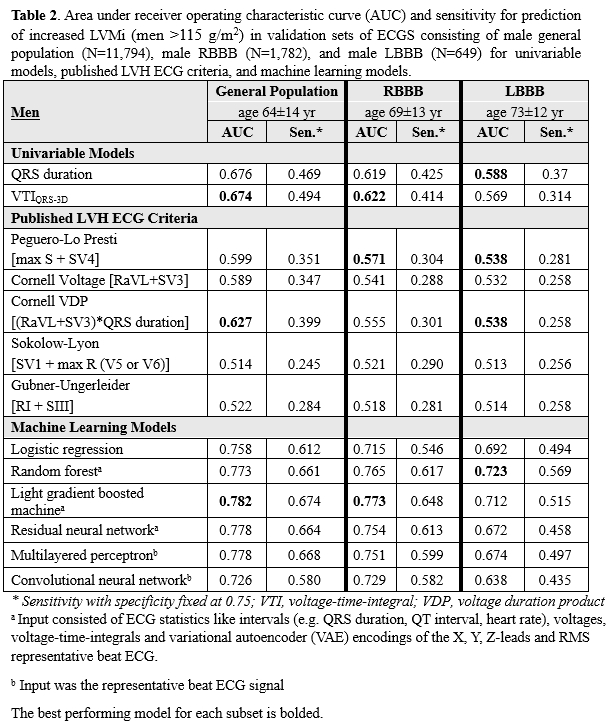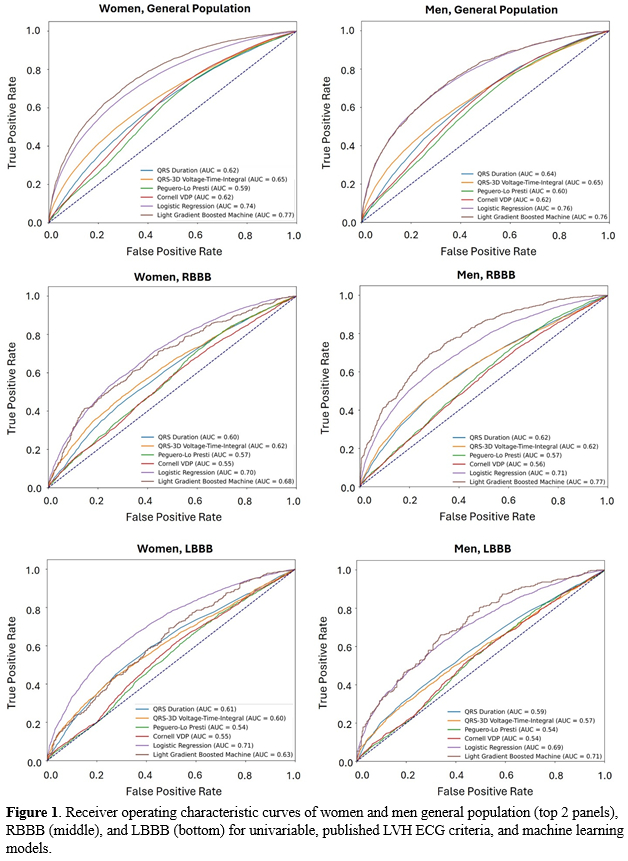Final ID: Mo2146
Classifying Left Ventricular Hypertrophy from ECG in Overall Population and Bundle Branch Blocks: Machine Learning Models are Superior to Published ECG Criteria
Abstract Body (Do not enter title and authors here): Background: Published ECG criteria for left ventricular hypertrophy (LVH) have low diagnostic yield, esp. with right/left bundle branch block (RBBB/LBBB). Machine learning (ML) may improve LVH classification.
Hypothesis: ML performs better than published LVH criteria to classify LVH from ECG in overall population, and subgroups of RBBB/LBBB.
Methods: In addition to standard ECG features like rates, intervals, axis etc., R, S and overall QRS amplitudes, and voltage-time-integrals were extracted from standard 12 leads and reconstructed vectorcardiographic X, Y, Z lead representative beats. Further, a variational autoencoder was used to extract latent encodings from the representative beats. ML algorithms (logistic regression, random forest, light gradient boosted machine, multilayered perceptron, residual network, and convolutional neural network) were trained to predict LVH (LV mass index women >95, men >115 g/m2) from ECG features on a training set of adult ECGs and echocardiogram within 45 days of each other (general population N=240,476, RBBB n=22,110, LBBB n=12,563). We obtained ROC AUCs in a separate validation set for LVH classification by (a) individual ECG variables, (b) published LVH criteria and (c) ML models.
Results: As shown in Tables 1-2 and Figure 1, for LVH classification among the validation sets, AUCs were highest for ML models, intermediate for univariable models and least for published criteria (best ML model vs. best criteria: general population women 0.77 vs. 0.63, men 0.78 vs. 0.63; RBBB women 0.70 vs. 0.57, men 0.77 vs. 0.57; LBBB women 0.71 vs. 0.55, men 0.72 vs. 0.54).
Conclusions: ML models perform better than published LVH criteria at classifying LVH from ECG in overall population, RBBB and LBBB.
Hypothesis: ML performs better than published LVH criteria to classify LVH from ECG in overall population, and subgroups of RBBB/LBBB.
Methods: In addition to standard ECG features like rates, intervals, axis etc., R, S and overall QRS amplitudes, and voltage-time-integrals were extracted from standard 12 leads and reconstructed vectorcardiographic X, Y, Z lead representative beats. Further, a variational autoencoder was used to extract latent encodings from the representative beats. ML algorithms (logistic regression, random forest, light gradient boosted machine, multilayered perceptron, residual network, and convolutional neural network) were trained to predict LVH (LV mass index women >95, men >115 g/m2) from ECG features on a training set of adult ECGs and echocardiogram within 45 days of each other (general population N=240,476, RBBB n=22,110, LBBB n=12,563). We obtained ROC AUCs in a separate validation set for LVH classification by (a) individual ECG variables, (b) published LVH criteria and (c) ML models.
Results: As shown in Tables 1-2 and Figure 1, for LVH classification among the validation sets, AUCs were highest for ML models, intermediate for univariable models and least for published criteria (best ML model vs. best criteria: general population women 0.77 vs. 0.63, men 0.78 vs. 0.63; RBBB women 0.70 vs. 0.57, men 0.77 vs. 0.57; LBBB women 0.71 vs. 0.55, men 0.72 vs. 0.54).
Conclusions: ML models perform better than published LVH criteria at classifying LVH from ECG in overall population, RBBB and LBBB.
More abstracts on this topic:
Adipose tissue plasticity in response to early pathological stress on the heart and mediation by adipose thermogenic activation
James Natasha Maria, Stanford Kristin, Challa Azariyas, Vidal Souza Pablo, Pardeshi Parth, Maurya Santosh, Wang Yang, Baer Lisa, Carley Andrew, Lewandowski E Douglas
Association of iron deficiency correction with the improvement of left ventricular systolic function in patients within 12 months after myocardial infarctionKhastieva Dilyara, Tarasova Natalia, Khasanov Niiaz



